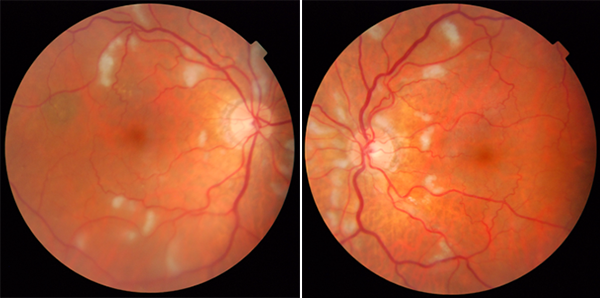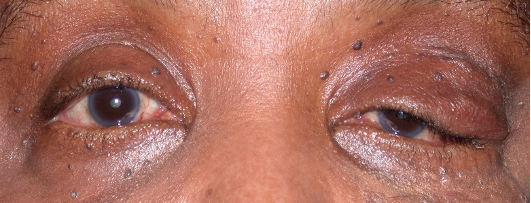
Immune System Disorders and the Eyes
Immune system disorders can affect virtually any part of the body, including the eyes. Common conditions include rheumatoid arthritis, lupus, scleroderma, Sjogren’s syndrome, multiple sclerosis, and inflammatory bowel disease. Effects on the eyes range from mild redness and dryness to severe inflammation (iritis or uveitis) to effects on the blood vessels and nerves (vasculitis, optic neuritis) which can potentially cause blindness.
| Immune System Disorder | Associated Eye Condition(s) |
|---|---|
| Rheumatoid arthritis | dry eyes, episcleritis, scleritis |
| Lupus | dry eyes, uveitits, vasculitis |
| Sjogren’s syndrome | dry eyes |
| Inflammatory bowel disease | uveitis |
| Ankylosing spondylitis | uveitis |
| Scleroderma/Systemic sclerosis | dry eyes, vasculopathy |
| Multiple sclerosis | optic neuritis, double vision |
| Sarcoidosis | uveitis, lacrimal gland enlargement, eyelid nodules |

Funduscopic photo of an 86-year-old woman with scleroderma/lupus overlap syndrome demonstrating multiple cotton-wool spots on the retina of each eye. Cotton-wool spots are whitish-yellow fluffy areas on the retina which represent occlusions of small arteries. While they are typically seen with severe diabetes and high blood pressure, they may also occur with certain immune system disorders.

A 74-year-old woman with sarcoidosis affecting left upper eyelid and lacrimal gland.
Any patient with a known immune system disorder who experiences new eye symptoms should be examined. Often, primary care physicians and rheumatologists who are evaluating a patient for a potential immune system disorder will request an eye examination to assist with the diagnosis. Eye findings can lead to earlier and more accurate diagnoses allowing quicker treatment with many of the new immune modifying medications now available.
Read Dr. Warwar’s article on lupus/scleroderma and cotton wool spots and more published article content at:
https://warwareyegroup.com/about/our-doctors/publications/